The Luminous Veil, Toronto ON
PUBLIC ART / URBAN HEALTH INFRASTRUCTURE
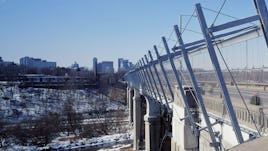
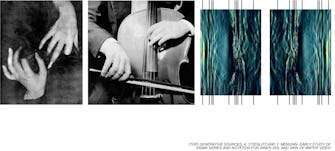
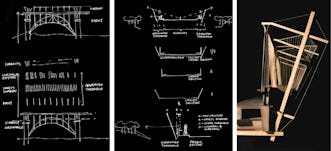
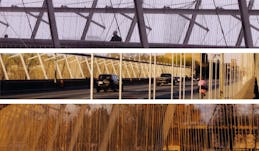
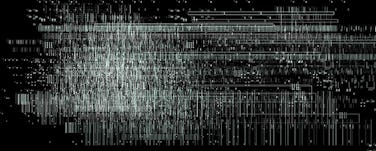
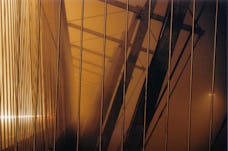

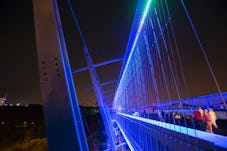
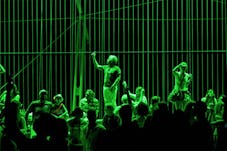
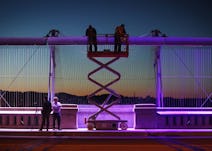
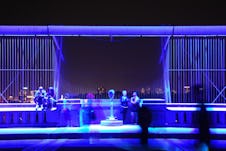
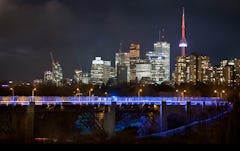
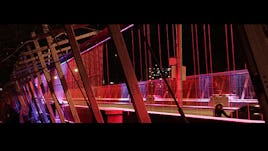
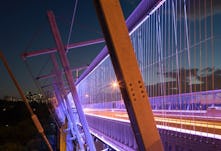
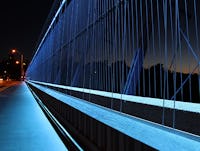
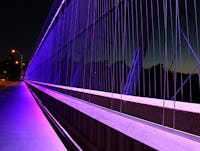
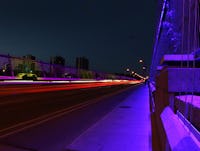
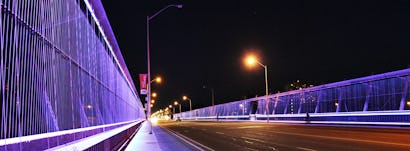
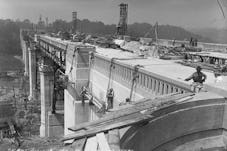
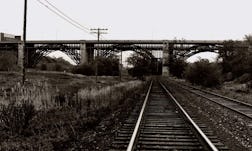
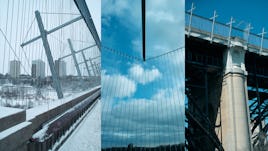
Prior to forming RVTR, Kathy Velikov and Geoffrey Thün collaborated with their former professor Dereck Revington on a two-stage national competition for the design and construction of a ‘suicide barrier’ proposed to be constructed on Toronto’s Prince Edward Viaduct (Bloor Street). The Viaduct is one of the city’s most revered pieces of civil engineering and greatest civic monuments whose contested history had been made popular through Michael Ondaatje’s novel In the Skin of a Lion. At the time, it was also (second only to the Golden Gate Bridge in San Francisco) a major North American site for suicide. Vulnerable communities referred to it as The Bridge of Death. Of the five finalist submissions, the Luminous Veil was the only entry that did not take the approach of ‘decorating’ an engineered structure with elements comprising ‘public art’. Rather, the proposal aimed to design a thickened tensile screen whose conception, composition, and capacity to transform both the social space of the bridge deck, and its fatal threshold would constitute an integrated work of civic generousity.
TUNING
“ We vibrate like the untouched violin string lying next to its neighbour,
trembling in sympathy though unstroked by the bow “
Yehudi Menuhin
BOW, VEIL AND TRUSS
The Luminous Veil is conceived as a tremulous spatial fabric strung against the sky and running from bank to bank on both sides of the bridge. Tensioned between a horizontal ‘V’ truss (suspended sixteen foot above the deck) and the balustrade, its oscillating double skin holds the fatal threshold between the sidewalk and the valley below. It is designed both as a deterrent to suicide, and as a kinesthetic field of reflection. The parallel veils on both sides of the bridge create a lightly contained space on the deck, giving it volume and definition through a tracery of shimmering vertical lines superimposed on sprung bow-spring masts, which fold into the valley beyond.
This subtle re-definition of the deck creates a new urban condition which complements the grace and grandeur of the historical viaduct upon which it rides. A lively field of force springs into place. The potential of the deck as a place to be, as well as a dynamic field to cross is fulfilled. The simple joys of passage, of lightness and transparency, are intrinsic to the design, as are the transformations wrought by weather, by the play of light and shadow and the moments of pause when the uniqueness of time and setting are thrown into relief
The bow-string masts, outriggers and brackets, are constructed of pre-fabricated sweep-blasted galvanized steel. The “V” trusses are welded rolled steel plates finished in a similar manner. The 16,438 individual rods are 5/16” post-tensioned stainless steel with custom swaged connectors. An inner rail of ipe wood provides a point of intimate contact relative to the relentless scale of both its host infrastructure, and the cultural conditions that surround it.
The original competition proposal of 1998 imagined the Veil as an armature that would form a substrate for artificial lighting to enhance the sigma-series derived patterns of the inner veil. The project also proposed to close the space of the bridge to traffic for scheduled civic events and celebration – a concept that had been central in recasting the popular imagination around sites of jumping suicide in other international contexts. During the process of taking the project from concept to construction, relentless value engineering, misinformed public opinion, and civic corruption threatened the project. With financial support from a private donor, construction of the p[rimary structure was finally completed in 2003. The shadow of suicide that haunted this site was slowly lifting. A new public space was created on its deck and the joy and safety of passage between the downtown and the east end of he city was secured.
During the years that followed, Revington continued to advocate for the completion of the project.
Although anticipated in the original design, the lighting of the Veil was not realized until July 4 2015 as the City of Toronto’s Legacy Art Project celebrating the opening of the Pan American/ Parapan American Games. The lighting concept and composition by Dereck Revington Studio was executed in collaboration with Lighting Designers and Engineers Mulvey and Banani International. The Luminous Veil is illuminated from dusk till dawn each night of the year: for 16 hours on the winter solstice, 9.15 hours on the summer solstice and for 12 hours a night on average throughout the year. Rising as the sun descends, bridging twilight, it follows a recurring cycle, changing in hue and intensity in continuous linear gradients and in response to wind direction, velocity and ambient temperature.
Throughout this chromatic nightly cycle, diaphanous waves of contrasting color play dynamically on the strings of the Veil. A lance of light hovers mysteriously above each of the lookouts crowning the piers. The lighting is subtle and evanescent, inviting participation in the invisible forces moving around us as we pass from place to place, taking on the atmosphere of the surrounding world, expressing a whole that changes; second by second, day by day, and through the round of the seasons. An ever-changing luminous gateway welcomes you into the mysteries of the valley, the lake, and the city they sustain.
A total of 2863 linear feet made up of 600 RGB color changing luminaires with custom LED binning to capture the correct hues, illuminate both sides of the 131’ (450m) bridge. In order to reduce maintenance and improve system reliability all LED drivers were remote mounted in two climate-controlled cabinets in easily accessible locations off the bridge; each supplies a side of the bridge with power. All control components are stored in a climate controlled cabinet on the west side of the bridge. The system’s DMX control is carried over a fibre loop which keeps all quadrants of the bridge in communication with one another. In all the lighting system required over 45,000 feet of power and control cabling carefully concealed within the structure. A weather sensor mounted to the top of the Veil outputs a digital weather signal received by a customized computer program that then converts the received parameters into a real-time video that is then outputted to a video processor which then maps the video signal across the luminaires. The project was under very tight timelines. Tendered in January of 2015 the installation was completed in just six month, illuminated on July 4th, 2015 during opening ceremonies of the 2015 Pan American/ Parapan American Games.
The Luminous Veil was selected for a 1999 Canadian Architect Award of Excellence, A 2003 CISC Steel Design Award for Innovative Engineering, and a 2003 CMHA (Canadian Mental Health Association), Achievement Award for the project’s contribution to both the built realm and public discourse around mental health and the design of cities. Most recently, the Luminous Veil was awarded the 2017 DARC Award for Best Light Art Scheme – 20 years after its initial conception.
Team
| Design Team | Dereck Revington (1998-2015), Geoffrey Thün (1998-2000), Kathy Velikov, Abel Gill (1998), |
| Structural | Morden Yolles, Kari Valli (Yolles Partnership) |
| Specifications | Brian Ballantyne |
| 2015 Lighting Project | City of Toronto’s Legacy Art Project |
| Design Team | Dereck Revington Studio, Studio F Minus |
| Lighting Design | Mulvey & Banani Lighting |